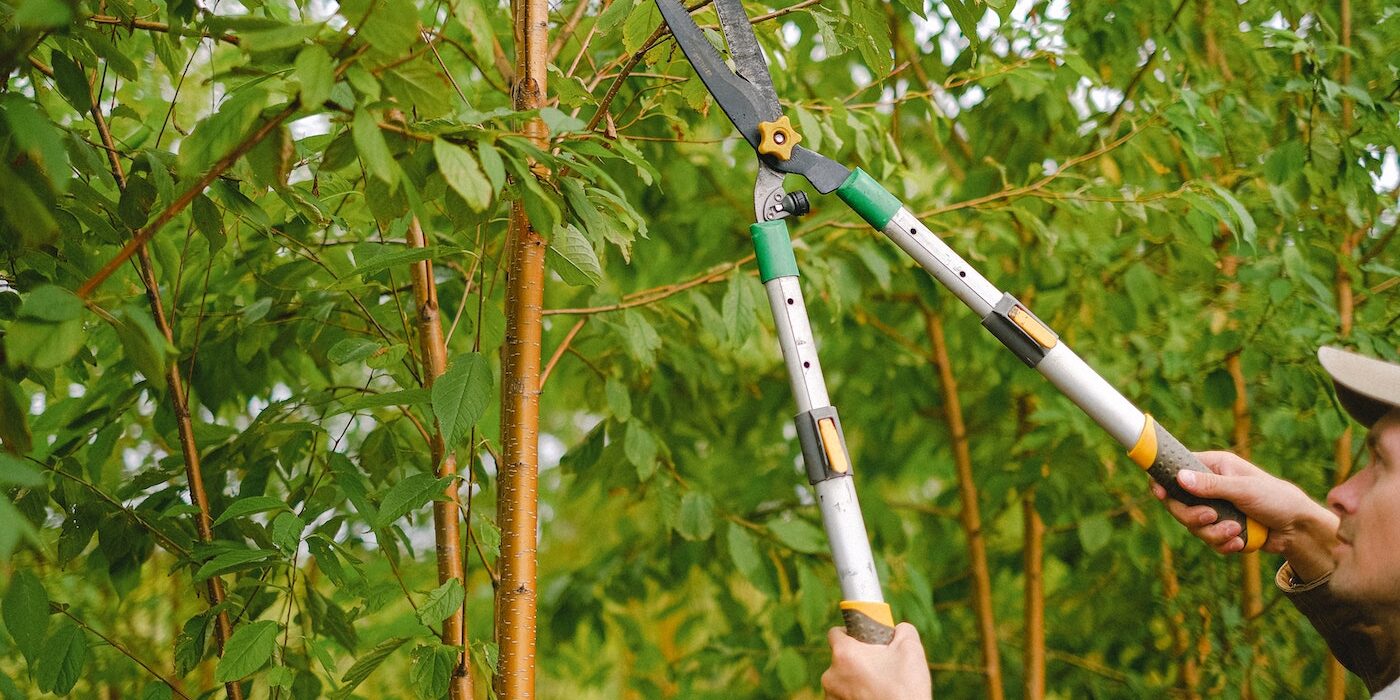
If you own your home or a business, chances are that you have at least one tree on your piece of land.
Trees give us shade, they can give us fruit based on the type of tree that you have, and they can be a joy to look at. But sometimes it becomes necessary to trim your tree. We’ll look at some reasons that people trim trees and we’ll give you some tips and techniques to do it so that you can trim and prune your trees safely.
REASONS YOU MAY WANT TO PRUNE OR TRIM A TREE
Usually when you prune or trim a tree, it’s for one of three reasons: health, safety or aesthetics
- Health – Sometimes it’s possible to save a tree that’s infected by pruning away the limbs and branches that are affected. When you thin the tree’s crown it will improve airflow, and this can be extremely beneficial. If your tree’s branches that are rubbing together or crossing, they need to be trimmed so they don’t unexpectedly fall.
- Safety – Broken or dead limbs and branches have the ability to fall off anytime, and this can lead to safety problems. Also, if you have a tree that is obstructing the view and making it hard to see when you’re driving, you should trim them so you can see easier. There are also times when branches and limbs get too close to your utility lines. If this happens, you should get in contact with your utility company.
- Aesthetics – Effectively pruning your tree will help it maintain its appearance and shape. But you shouldn’t try imposing an unnatural size or shape on your tree. The amount of pruning and trimming that’s going to be needed could damage it seriously.
GENERAL TIPS FOR TRIMMING YOUR TREES
It’s a good idea to prune or trim trees when they are dormant. Even though it’s possible to prune pine trees anytime, you’re better off doing it when they’re dormant as well. The only time you shouldn’t wait is when it could be hazardous.
Make sure you’re conscious about the branch’s size you’re taking off. If it’s under five centimeters around, it’s fine to remove it. If it’s 5 to 10 centimeters, it may not be a good idea. If it’s over 10 centimeters, it should only be removed if the reason is very good.
Florida Tree is the most trusted and top rated Tree & Ground Maintenance company in the area. But don’t take our word for it, see what your neighbors are saying about us and read our reviews.
TIPS FOR TRIMMING
- The branches that you are trimming should have narrow, V-shaped angles. Any branches that are U-shaped and strong should be left alone.
- Lateral branches should be anywhere from ½ to ¾ of the stem’s diameter where it attaches. If not, you should let them be.
- When you are done pruning, you should have a ratio of living crown to height of the tree of two-thirds.
- Try pruning away the branches when they’re young. They’re a lot easier to manage then and you lower the risk of leaving really nasty scars.
- Don’t trim branches too long or too close. You shouldn’t remove the branch’s collar or leave a big stub.
TIPS FOR TREE PRUNING
The techniques and tips that follow will help with guiding you if you plan to prune one of your trees or if you’re simply looking to become educated about the usual maintenance and care techniques for tree trimming.
CROWN THINNING
Should you need to thin your tree’s crown, remember these techniques and tips.
- Make sure that you are evenly spacing lateral branches, especially when you are pruning a young tree.
- Prune away any branches that are rubbing against others or crossing them.
- Don’t remove more than a quarter of a tree’s living crown during one pruning. If this needs to be done, you should do it over several years.
CROWN RAISING
In order to give extra clearance for pedestrians along with other reasons, it’s possible to raise your tree’s crown by pruning your tree carefully. Maintain the live branches on a minimum of 2/3 the height of the tree. If you’re removing to many of the branches on its bottom half, your tree might not develop a stem that’s strong.
CROWN REDUCTION
- If you find that you have to remove over half of a branch’s foliage, simply remove your entire branch.
- Only reduce your tree’s crown if very necessary. Prune the lateral branches that are a minimum of 1/3 the stem’s diameter which needs removing.
- Before you make a cut, search for its branch collar. This grows from the tree’s stem tissue at the branch’s bottom base. Look for the ridge, and this will be on its upper surface, parallel to the branch’s angle at the tree’s stem.
- Always make sure you’re cutting outside the branch’s bark ridge and angling the cut away and down from its stem. Make sure you’re not injuring its branch collar.
- Use this technique for pruning living and dead branches.
If you have a stem that is extra-long, the technique you should use Is the three-cut. This starts by making a notch upon the stem’s side facing away from that branch you’re retaining. The second cut’s made inside the branch’s crotch and just above its branch ridge. Then the third cut is going to remove its stub because it cuts through its stem parallel to its bark ridge.
These techniques and tricks will help you keep your tree healthy and help you to prune your trees in a way that is safe for you. Remember, if the tree’s branches are close to power lines, call your utility company. They’ll come and take care of the problem and usually for free. The last thing you want is to cause a problem or be injured.

